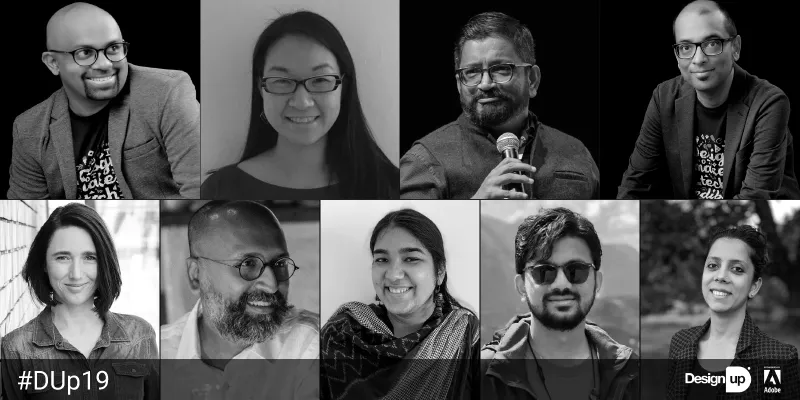From service to strategy: DesignUp 2019 frames opportunities for design leaders in business
The annual DesignUp conference offers a wealth of frameworks, case studies, and tips for designers at the forefront of the creative economy.
The DesignUp 2019 conference wrapped up in Bengaluru with an outstanding lineup of keynotes, panels, pitches, workshops, and installations. It is regarded as one of the leading international design conferences, showcasing best practices and emerging trends.

See our coverage of the conference editions from 2018 and 2017, as well as our d-Zen (‘Design Zen’) section for more design resources. As media partner for the conference, YourStory features in-depth interviews with some of the keynote speakers: Giles Colborne, Rufus Deuchler, Param Venkataraman, Simone Rebaudengo, Scott Sorokin, and Gurman Bhatia.
In Part I of our coverage of DesignUp 2019, we feature takeaways on design teams and creative cultures. In Part II, we dig deeper into emerging trends and ethical practices for designers.
Instilling a creative culture
Creating a design-centric organisation involves creative clarity, explained John Kolko, Partner at Modernist Studio, and Founder, Austin Center for Design. He broke this down into four steps: acknowledging feelings, taming ambiguity, unleashing free spirits, and communicating a clear vision.
The iterative cycles of design should include an open critique, but this should not be seen as personal attacks. Making artefacts can help resolve some of the ambiguity of top-down requirements and embedded constraints.
Having too many rules can hamper creativity. But having no rules can lead to magic as well as broken glass, John cautioned. Design leaders need to own the consequences of unhampered behaviours, which may lead to conflict with other managers.
Even when the answer is not clear, design leaders need to frame and articulate a vision. “Humanise the opportunity. Show them a reason to believe. Bring the design criteria to life,” John advised, drawing on demystifying the educational loan market as an example.

Design talent management
Talent management is a key competency for design leaders, explained Andy Budd, Founder of Clearleft and Curator of the UxLondon conference. The best designers want growth and not just money, and organisations need to become talent magnets.
Showing a company’s good work attracts talented designers. The pool mix should include “pioneers, settlers and town-planners.” It is equally important to retain this talent pool by living the mission and vision of the organisation, Andy emphasised.
The workspace should be creative and inspiring, and adequate time and activities should be scheduled for designers to experiment and innovate. These can include personal time for pet projects, as well as hack-days. Psychological safety, structure, clarity, meaning, and impact are key for high-performance teams, as shown by companies like Google.
Leadership coaches and mentors can help in this regard, Andy recommended. Design leaders should look after their teams, and shield them from unnecessary criticism from other parts of the organisation.
“Praise publicly, critique privately,” Andy advised.

Design Leadership
For designers to have a stronger say in business strategy, they need to get over the mentality that business is “boring”, advised Param Venkataraman, Chief Design Officer, Fractal Analytics. He spelt out a three-layer pyramid for design leadership: business, craft, and self.
Designers should reflect on how they fulfil the strategy and purpose of their organisations. He shared design examples from Aimi (an app to monitor and control smoking habits) and Dr Reddy’s Labs (“Good healthcare can’t wait” was the vision statement).
Designers need to navigate corporate politics and understand how to work with “sceptics, neutrals, and enthusiasts”. These archetypes are spread across the top, senior, and middle levels of organisational managers; it is not always enough to get buy-in from the top for a design initiative.

Organisational archetypes
Other archetypes in the world of design and communications were highlighted by Karen Faith, Director of Strategy at SubRosa. She classified these empathetic archetypes as inquirer, seeker, sage, convener, confidant, cultivator, and alchemist. Understanding these multiple and at-times overlapping roles can improve the empathy quotient in organisational design teams.
Empathy between two parties depends on clarity and alignment between what the communicator meant and said, and what the recipient heard and understood. In that regard, design thinking adds a strong element of empathy to the reason-based scientific method, Karen explained.
Socialisation of the design narrative
Designers need to document their work regularly and comprehensively, create the narrative, and socialise it, advised Hardik Pandya, Designer at Google. He is the Design Lead for Search Suggestions and the Google Homepage, and credits his documentation practices for his success in the company.
With a number of ongoing projects and intertwined workstreams, designers need to appreciate the role of documentation in the ‘BigCorp.’ This is particularly important in the context of different release cycle speeds, stakeholder priorities, and even time zones.

The context, stakeholders, internalities (eg. strategy, constraints) as well as externalities (eg. competitor positioning, market moves) need to be clearly captured in the documentation. Otherwise, there will be needless misunderstandings and “Chinese whispers,” Hardik cautioned.
As the design is taking shape, socialising this narrative involves roadshows and one-on-one meetings. However, Hardik warned against a “grand reveal” bringing all stakeholders together in one room.
“Resolve locally before you present collectively,” he advised. Subsequently, the documentation should be kept alive through iteration and maintenance, and tagged with relevant status flags.
Design and partnerships
Designers will play an increasingly important role in a world of connected people, things, and disciplines, explained Scott Sorokin, Global Head of Infosys XD (Experience Design). Design teams are magnets for multi-skilled “versatilists” in this regard.
The future is about the interaction of digital and design, and design teams need to master data science as well. Experience is the new battleground, powered by technology, Scott added.
Scott advised organisations to invest in strategic design training to meet larger industry challenges. Organisations need to accept that the creative process of design at scale can also be messy, and needs organisational partnerships. In this regard, Infosys has teamed up with the Rhode Island School of Design to set up the Centre of Complexity.
The partnership is intended to help address the complex and disruptive forces of digital change. It will foster the strengthening of designers at Infosys and explore new ways of solving challenges at the intersection of design, technology, and industry.

Case study: design at 3M
Industry leaders practice design as a strategy and not just design as a service, explained Eric Quint, VP and Chief Design Officer, 3M. Design as a service is driven by considerations of projects and costs, and is fragmented. Design as a strategy focusses on business value and portfolios, and is holistic.
At 3M, design is at the heart of the organisation, operations, and culture. “Inclusion is the oxygen for participation in design,” Eric said. Its creative spaces for design are open, inspirational and cross-disciplinary.
Collaborative creativity helps many smaller ideas build on each other. Designers bring creativity to the table. “Anyone can be part of design thinking, but not everyone is a designer,” Eric clarified. Design-thinking helps an organisation through co-creation and storytelling.
3M has rolled out a visual identity system, consistent across all B2B and B2C touchpoints. It has worked on a range of design initiatives with cultural stories of Indian Railways (“heritage coaches”) and in the US healthcare ecosystem (reducing wastage).

Design in startups
In a separate interview, John Kolko also offered advice for techie founders of startups. “Treat design like a first-class citizen. Hire a design leader at the top level of the company, as a peer to the CEO,” he recommended.
The design leader should be empowered to scale at the same pace as other competencies, like development, sales, and marketing. “Compensate designers at the same level as other parts of the business. If you send a signal to the company that design matters, you'll attract great design talent and improve the qualities of your products and services,” John added.
Design documentation becomes increasingly important as startups scale, advised Google’s Hardik Pandya. “It is a good habit to start,” he said, even if design communication is easy at early stages when all team members are present in the same room.

Organisational design maturity
The DesignUp team has also put together the ‘Deconstruct’ report on the status of India’s design industry. It draws on Sabine Junginger’s framework of design maturity in organisations, in four phases: separate, peripheral, central, and integrated.
The report also looks at design management and career paths in product companies, design studios, consultancies, Indian companies, and MNCs. Organisations measure design impacts in terms of user conversions, satisfaction, retention, engagement, and adoption; these are reflected in metrics like usability, delight, and NPS.
The report has implications for how designers need to collaborate with other organisational counterparts, the soft skills needed for co-creation, and roles/titles. Designations for designers in organisations include Lead, Head, Principal, VP, Director, Creative Director, Design Manager, and Chief Design Officer.
In sum, the speakers at the conference iterated that this is a great time to be a designer, and showed how outstanding designers are stepping up to the challenge and taking on greater roles in business and strategy. This involves mastering a range of hard skills and soft skills as well, particularly in the context of organisational partnerships.

(Edited by Saheli Sen Gupta)









